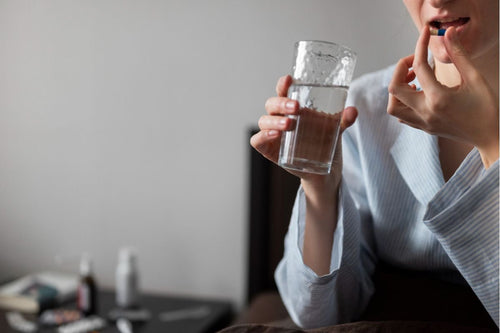We all know that when you're dragging in the morning and need a quick pick-me-up, a hot cup of coffee is a reliable solution. But what if it's the dead of summer and you don't want to down a hot cup of coffee?
Today, we're going to explore something a little different: cold drip coffee.
What exactly is cold drip coffee? Is it better for you than traditional coffee? And is cold drip coffee the same thing as a cold brew?
We know you have questions, and we'll answer them all for you. If you're already down with cold drip and just trying to find out a little more about your cold brew, or if you're looking to try something completely new - we've got you covered.

What Is Drip Coffee?
Regular drip coffee is a method of brewing that uses a filter and gravity to brew the coffee directly into a cup or carafe. It can be used for both hot and cold brews.
When we talk about cold drip coffee specifically, it refers to a slower process than traditional drip coffee. This is because instead of pouring heated water slowly over ground beans in the filter basket, cold drip coffee requires a longer process using either ice or refrigerated water. Essentially, instead of extracting with pressure or with heat, as regular coffee espresso does, cold drip brewing extracts the flavour with time.
And What Is Cold Drip Coffee?
If you're even a semi-regular cafe-goer, chances are that you've seen a cold drip coffee machine before.
There are many amazing coffee makers to choose from nowadays, none of which are as visually striking as a classic cold drip coffee setup. The eye-catching three-beaker setup that serves as the cold drip coffee maker has become a staple in many coffee shops. Whether you want to try making a cold brew at home for yourself, or just want to pick one up at your local coffee shop - it always helps to know the basics.
Apart from a smoother + sweeter taste and the obvious temperature difference, one of the main drawcards to cold drip coffee for many people is its ease on the stomach and digestive system. That's because, according to Insider, cold brew coffee generally contains up to 70% less acidity than a regular cup of java.
Cold drip and cold brew coffee are far less likely to irritate those with IBS or other stomach issues that are often exacerbated by espresso and other hot coffee extractions.
How Does the Cold Drip Coffee Brewing Method Work?
Cold drip coffee is made by releasing drop after drop of cold filtered water from the top beaker into a bed of coffee grounds loosely packed in the mid-beaker. These water drops slowly work their way through the grinds and then collect as cold drip coffee in the bottom and final beaker. As the water passes through the coffee in the mid-beaker, it draws out all of the delicious flavours and aromas from the ground coffee.
Don't be mistaken - cold drip coffee isn't the same as cold brew coffee, it's a much more refined and delicate method that allows for much more control over your coffee strength and flavour profile.
Just like any cup of coffee, cold drip can be mixed with a wide array of milks, creamers, and other flavour enhancers to make your favourite brew, no matter your style.

Cold Brew vs Drip Coffee - What's the Difference?
Although both cold drip and cold brew coffee are made using cold water, they are in fact very different. While cold drip coffee is made by slowly releasing drips of water into coffee grounds, the most common way to make cold brew coffee is with the immersion method. This is where the ground coffee and cold water are placed in the same vessel and then left for an extended period of time before being filtered.
As well as using a different extraction process, cold drip and cold brew coffee are different in many ways.
Brewing Time:
Depending on how strong you like your coffee, the brewing time will vary. However, it is generally recommended that cold brew coffee is left to steep for as long as 12 to 18 hours before being filtered several times to remove as many of the coffee grounds as possible. Cold drip coffee, however, can be made in as little as 3 hours, although again, this will vary depending on your required strength.
If you're looking for a full breakdown of how caffeine is extracted from ground coffee and absorbed into water - check out this great breakdown here.
Equipment Required:
Cold brew coffee is a much simpler process than cold drip coffee, you can make it in a cold brew tower or machine like the BOD Coffee Brewer, or simply using a mason jar and a paper filter. Cold drip coffee requires more specialized equipment, like The Yama Tower, which we explore in more detail below!
Taste and Texture:
Both cold brew and cold drip coffee will taste markedly less bitter than coffee made through hot brewing methods. This is because steeping ground coffee at cooler temperatures draws out less acid and oils, giving it an overall smoother and sweeter flavour. Cold brew coffee should be the lighter of the two and is a great base for iced coffee. While it is often diluted it is still normally served black as it’s subtle flavours can be lost if you add milk. If you do like milk in your coffee then cold drip is the best option for you; it is more full-bodied and rich, and the stronger coffee concentrate will carry through milk. That being said, in my opinion, this coffee is still best if you serve it over ice to get that strong, rich and deliciously sweet coffee flavour.
Strength:
If served in its “raw” form, straight after brewing, cold brew coffee is the stronger of the two. That being said, cold brew coffee tends to just be a base that is then diluted and served over ice, while cold drip coffee is drunk in a smaller, more concentrated dose. When consumed in this way, cold drip coffee is definitely stronger, however, both cold drip and cold brew coffee are stronger and more full-bodied than hot-brewed coffee.
Making coffee through either cold brewing or cold drip results in a delicious, rich and flavourful coffee, but for me, cold drip is superior. From a shorter brewing time, to a stronger flavour, it ticks all the right boxes for my morning cup of Joe!
The quick video below is a great breakdown of some of the key differences between immersion cold brew and cold drip coffee!
Drip Coffee vs Espresso - What's the Difference?
Cold Drip coffee is made by dripping cold water slowly over coffee grounds for a prolonged period of time, resulting in a smooth and low-acidity concentrated drink.
On the other hand, espresso is a small, strong, and syrupy shot brewed quickly with pressure. The difference in ground-to-water ratio and grind size leads to strong and concentrated flavors in espresso.
Cold Drip coffee is best served over ice and makes a great beverage for hot days, while espresso is usually served hot and enjoyed as an energizing pick-me-up. Both methods can be customized with flavorings and dairy products to suit individual preferences.
How to Make Cold Drip Coffee
To make this delicious coffee elixir, you'll need a great bag of coffee and a three-beaker tower setup that looks nothing like a regular hot coffee pot!
The Top Beaker
The top beaker holds your cold water and typically a little ice. This beaker controls the drip rate, which varies from recipe to recipe. This a highly specialised piece of equipment and where you really 'dial in' your brew.
The Middle Beaker
The medium beaker holds your coffee filter and ground coffee beans. Typically, medium-grind coffee is used - but you can experiment with finer or more coarsely-ground beans to find the perfect recipe for you!
The rate at which the cold water drips from the top beaker into this beaker is the main factor that determines the strength of your brew.
The Final Beaker
The third and final beaker is where all of your filtered coffee goes for collection. Once your cold drip coffee makes it to this beaker, it's ready to be served.
There are tons of cold drip coffee recipes around, so no matter what flavour profile and caffeine content you enjoy, you'll have no problem finding one to suit your preference.
Check out one of the most well-regarded and most-loved cold drip towers on the market below - The Yama Tower
FAQs About Cold Drip Coffee
Is cold drip coffee stronger?
Yes, cold drip coffee is typically stronger than regular hot-brewed coffee due to its concentrated nature. The extended contact time the coffee has with water during the slow drip process extracts more flavour and caffeine from the beans.
How do you drink cold drip coffee?
Cold drip coffee is usually prepared as a concentrate and is best served over ice and/or diluted with water or milk. It is a refreshing drink, perfect for hot weather, and can be enjoyed black or with added flavours like syrup or cream.
What coffee to use for cold drip?
You can use either filter roast or espresso roast coffee for cold drip, depending on what you want to achieve. If you want a sharp and fruity taste to drink without any additives, then we suggest using a filter roast. However, if you want a more daring and fuller flavour, especially for those who mix milk with their coffee, espresso roast coffee would be a perfect choice.
Can you store drip coffee in the fridge?
Yes, you can store cold drip coffee in the fridge to keep it fresh for up to two weeks. The resulting brew is a concentrate, so dilute it 1:2 with water or milk and plenty of ice before drinking. Enjoy a refreshing and flavourful cold drip coffee anytime!
The Iced Drip Wrap Up
If it's a steamy hot day or you're simply finding that regular hot coffee is a bit too harsh on the stomach - cold drip coffee will be your best friend.
As a lover of the 'coffee ritual', I find this a super fun way to make my brew with all of the control I need to get the strength and taste I'm after.
Whether you're swinging past your local cafe or more interested in a home set-up - be sure to try a few different recipes to find the right brew for you!















